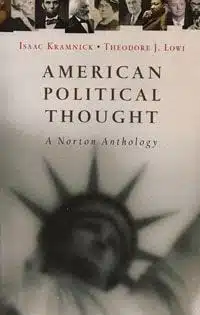
Although Will Ferrell’s character Ron Burgundy popularized it again recently, the phrase “agree to disagree” has been around for some time. There are just some topics – usually related to sports, religion and politics – that most people do not see to eye on and when we don’t, we graciously acquiesce.
The same cannot always be said of anthologies, which represent a cross-section of work tied to a common theme. Traditionally, most people do not agree on the content of anthologies – whether they are literature, film, music or something else – because the selection of contributions is so selective. And while most people could be cajoled to agree on core political or economic principles, getting people to agree on designating certain books or speeches as “essential” is a completely different ball game. The perpetual cause of contention for an editor is that someone always feels slighted and left out.
But of even more concern are not the fragile egos of academics, but the actual utility of the anthology itself, which arguably, was written to benefit a certain population to ameliorate their knowledge. One way to measure the “success” or benefit of an anthology is to examine how much the targeted audience should benefit from the collection.
The key then is to put together a collection of writing that is as comprehensive as possible and representative of many voices so that every vantage point and perspective can be edited and arranged in a cogent way that it informs and engenders debate. For their American Political Thought anthology, Cornell University Professors Isaac Kramnick and Theodore Lowi have contrived to present the diversity of American exceptionalism from two different paths – the liberal and conservative “traditions”.
The authors challenge Louis Hartz almost immediately, arguing that despite supporting Hartz’s famous theory of an American “liberal tradition” that he almost missed the boat by ignoring America’s “conservative tradition”. According to Kramnick and Lowi:
“America has a conservative political tradition that is just as broad and deep as the liberal tradition. But the two are rarely in true competition, let alone dialectical tension. They are as ships passing the day – conservatism being local and parochial, liberalism more cosmopolitan; conservatism concerned with order and obligation, liberalism with consequences and satisfactions. One pursues goodness, the other happiness.”
American Political Thought is, therefore, a collection of excerpts from speeches, articles, books, documents and Supreme Court majority, concurring and dissenting opinions. That is a lot of material and Kramnick and Lowi tackle their objective with relish – the book weighs in at 2.4 bs. and crosses 1,500 pages of everything from the Mayflower Compact (1620) to Amitai Etzioni’s “Communitarianism and the Moral Dimension” (2000).
Yet, despite the massive size, there are some notable omissions and following the trajectory of humbly agreeing to disagree, these omissions need to be highlighted. In the first place, the most glaring lack of material in American Political Thought is the lack thereof of said material after 2000. If this book had been released in 2002 or 2003 it would be excusable, but to look at all the contributions to the cannon in the last decade and not see any of that represented here is absurd.
For one, there is not a single essay or speech in this collection that reflects the abrupt change in American foreign policy following the terrorist attacks of September 11th 2001. How can Kramnick and Lowi include George Kennan’s famous article, “The Sources of Soviet Conduct” (1947), but leave out the Bush Doctrine of preventive war? But, there are even more egregious omissions. Where is President Obama’s speech from the 2004 Democratic National Convention, considered by many to be one of the finest political speeches of all time? What about Samuel Huntington’s last, major, controversial essay, “Jose Can You See?” from a 2004 issue of Foreign Policy?
There is also a notable dearth of major, influential Supreme Court opinions of the last decade. I will admit that the authors did present a good cross-section of the Court’s decisions from years past including Chief Justice John Marshall’s (in)famous opinion in Marbury v. Madison (1803) and Justice Oliver Wendell Holmes Jr.’s dissent in Lochner v. New York (1925). However, I was shocked to not read either the concurring opinion or one of the dissents (there were four) in Bush v. Gore (2000); Justice Antonin Scalia’s majority opinion in District of Columbia v. Heller (2008); or Justice Sandra Day O’Connor’s dissent in Kelo v. New London (2005). All of these cases have become substantial parts of American case law.
Finally, what is also troubling is the lack of diversity or the concentration of representative diversity in only race, African-Americans. I can’t deny that Malcolm X, bell hooks, Cornel West, Justice Thurgood Marshall and others don’t deserve to be in this anthology, but why did Kramnick and Lowi leave out the voices of other American ethnicities? How is it that in such a tome, there is not a single Latina/Latino, Asian, or Arab-American voice? Where is Ronald Takaki? Or Edward Said? The exclusion of such a large chunk of American diversity is bewildering.
Historian Daniel Boorstin once wrote that the historian’s game is “a waiting game” and that he [the historian] “commits himself to a wager that in the race between the destructive powers of time and the reminiscent, reconstructive powers of man, somehow man is always gaining a little.” No truer words were ever written about the responsibility of historians and social scientists to document events as they unfold to write the present into the future. Thus, though Norton’s anthology of American Political Thought is a substantial contribution to the field, it does not sit well with our goals as educators because of what it lacks: a truly representative manifest of the American experience.
